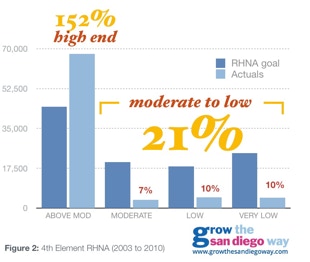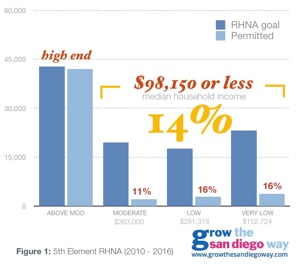Does San Diego’s Housing Shortage Justify GPA projects?
With seven General Plan Amendments and 10,000 houses heading towards the Board of Supervisors this year using the housing affordability crisis as a justification, we need to look at this claim with more scrutiny.
Does San Diego’s Housing Shortage Justify GPA projects?
With seven General Plan Amendments and 10,000 houses heading towards the Board of Supervisors this year using the housing affordability crisis as a justification, we need to look at this claim with more scrutiny.

Harry Jones, of the San Diego Union Tribune recently wrote about the County’s plans to rush seven projects through approval using a seldom-used tactic called “bundling” (or “batching) to avoid running afoul of state law, which limits general plan amendments to four in a year. The developers proposing these projects are claiming that issue of lower housing affordability necessitates setting aside the recently approved general plan to make room for more houses. Upon closer inspection, these claims do not stand up to scrutiny.
Overview
In this paper, we will show that the housing shortage is really a problem of housing affordability. The reason this is a problem is that most San Diegans cannot afford to buy a home in San Diego County.
General Plan Amendments
Amending the general plan is a big deal. With all General Plan Amendment (GPA) projects, the applicant needs to make a solid case for a GPA because it sets aside the “land use constitution” that is developed for a particular jurisdiction. San Diego County’s General Plan took 13 years and $18 million to develop. It received input from all the communities, the building industry and other stake holders and is the grand compromise to accommodate the the needed housing growth in the region (more on the General Plan here).
According to the state law, an amendment to the General Plan can only be made if it meets two important criteria: it must be “in the public interest” and must not be detrimental to public health, safety, and welfare.”
Using the recent Valiano project in Harmony Grove as a case study, the applicant attempts to make the case that the project is in the public interest because there is a housing crisis in San Diego County and that simply building more houses would alleviate that crisis. It is important to examine the assumptions that are being made here in order to determine the following about each particular project:
What is the nature of the shortage?
The County Planning and Development Services (PDS) Planning Commission Hearing Report on the Valiano project refers to the housing crisis as a justification for amending the General Plan. It states that because there is increased demand for housing in the region, the GPA should be allowed because it accommodates more housing in the region and that is a good thing.
So first we need to ask some basic questions: Is housing production down? Well, so far through the 5th Element of the Regional Housing Needs Assessment (the RHNA, pronounced “ree-nuh”) we are considerably below where we need to be. This interim report lays out where we are after 7 years through an 11 year cycle. The RHNA report compares the number of permits issued through 2016 with what the original goals of the RHNA were for this cycle and it shows that, overall, we are half of where we need to be at this point in time in the region.
So, that settles it. We haven’t built nearly enough houses, right?
Yes, but as always, the devil is in the details. The biggest issue with lack of housing supply, so the story goes, is that it drives up home prices. There are more people seeking homes than there are homes available. That is standard economics. However, if you look at the type of housing that is being produced and how we are delivering on this housing, you will see that we are overwhelmingly producing high end housing (above moderate) while massively under-delivering moderate income housing (or lower). Read on if you want to understand how that is possible.
What can San Diegans afford?
Unfortunately, home prices are the highest they’ve ever been and 74% of County residents cannot afford the average home in San Diego County. The median household income for San Diego County is $81,800. A person who makes $81,800 can afford a house worth about $295,400, at current interest rates (and with a $20,000 downpayment) or about $2,000 a month in rent. However, the median home price in San Diego is $550,000 and for newly-built homes, it is even higher ($646,000, according to CoreLogic via the Union Tribune). You would need to $126,000 per year to afford the median house in San Diego. So there is a problem here. It is not just about lack of housing but more importantly, that the housing we are building is too expensive for the average resident. So the solution is not just to increase overall housing, but specifically, build housing that people can afford.
So, how are we doing with building houses people can afford?
Unfortunately, not well at all. Most of the housing we’ve created in the past 15 years has been “above-moderate” (luxury) housing. The California Department of Housing and Community Development (HCD) has guidelines that define income categories that are used to define Moderate, Low and Very Low income levels. For San Diego, it is defined as follows:
A person who has moderate income can afford a house that is roughly $363,000. This is considerably lower than the median priced home, so clearly something is going on with regards to the production of different levels of housing product.
Figure 1 shows the RHNA housing goal versus permits issued, broken out by Above Moderate, Moderate, Low and Very Low income categories. The production of moderate income housing (or lower) is severely restricted versus the high end housing. In fact, we have only produced 14% of our goal for the current period so far. High end housing appears to be right on track, however. So the biggest issue is the lack of Moderate housing (with only 11% of the need being produced).
So, what this tells us is that even though the housing need for Moderate to Low Income housing in San Diego County is the greatest, we continue to oversupply the market with luxury housing that the vast majority of San Diegans cannot afford and we have been doing so for at least 15 years.
But if you increase the supply of housing at all levels, won't that bring costs down eventually?
That seems logical on the face of it and, in some areas of the country, it would make sense. The reasoning that the building industry uses is that if you don’t build enough of the high-end housing, then the high-income buyers will go and snap up the more affordable properties that working class families might buy and thus costs go up for everybody. While this might work in Texas, in the coastal areas of California, it hasn't seemed to work out that way. There is strong evidence, in fact, that that is not the case. In fact, all over California, there is a significant surplus of high end (above moderate) rental housing (300,000 units at last count according the California Department of Housing and Community Development, P28) while we are more than $3 million short on the Moderate and lower.
First it is important to note that Coastal California does not operate under the same assumptions as other markets because it is a “high-amenity” market, which, in economist-speak means it is an incredibly desirable place to live when compared to other markets and that demand drives up the cost because there is a ready supply of people who can afford it and are willing to move here from other cities given the desirability. (You can read more about it how this impacts affordability here: Pricing the Natural Environment: How Amenities Put a Premium on California Housing, UCLA Anderson Forecast).
And in San Diego, specifically, to see what happens if we build a surplus of high end housing, we need not look further than the last RHNA cycle for San Diego County. Looking back at the last RHNA cycle (the 4th Element from 2003 to 2010), we actually produced an oversupply of 152% of the houses needed in the Above Moderate category (see Figure 2). That’s right, we produced 152% more luxury homes than we needed, while only producing about 21% of what we needed in the Moderate to Low category–and that included 2 years of recession.
Did that over-supply result in home prices dropping? Well, no. Despite being over-stocked on higher end houses, housing prices have continued to escalate (with a dip during the recession) hitting their highest point in January of this year ($550,000). So there does not appear to be any correlation between oversupply of high end houses and housing prices. In fact the opposite seems to be the case. It seems we simply need to focus on Moderate, Low and Very Low income housing.
So what about these GPA projects? Won't they generate moderately priced housing?
There are approximately 7 projects that are being considered for General Plan Amendments this year (using an unorthodox technique known as “bundling” or batching to potentially approve 8 GPAs rather than the 4 that State Law normally allows). Of those projects none of them include an affordable housing element, though a few try to make the case that some of their housing types will be affordable. Based on market forces alone, most of the housing being built will “above moderate.” In other words, they are contemplating adding another 10,000 high end homes to the County when what we really need are “moderate” or lower.
Again, using Valiano as an example, if you read the County's report to the Planning Commission, they state very clearly that this project does not deliver any affordable housing as defined by the County of San Diego’s General Plan adopted in August of 2011:
The applicant, Integral Communities, says that they will provide a range of housing stock from 1800 square feet to more than 4,600 sf and that should provide housing that is affordable (though they don’t substantiate how).
However, based on median home sales prices in the immediate vicinity, at $266 per square foot, an “affordable” 1800 sf home would be worth $479,000 which is significantly higher (about $179,000 more) than what the median income household could afford.
In Summary:
Links:
Any proposed amendment will be reviewed to ensure that the change is in the public interest and would not be detrimental to public health, safety, and welfare.” (San Diego County General Plan, A plan for Growth, Conservation and Sustainability), Adopted August 2011) P1-15
“The reduced rate of housing production during the current Housing Element planning period has resulted in increased demand for housing in the region. Housing Element Policy H-1.3 provides direction for siting and increasing housing opportunities in the unincorporated county and states” (5-11-18 Valiano Planning Commission Hearing Report) P24


________
The number one problem we are facing in San Diego County is that we continue to churn out a surplus of luxury housing while completely ignoring the middle and lower end of the spectrum where everyone else lives.
________
The General Plan Housing Element designates affordable housing at a density of 10.9 du/ac or greater. The project’s proposed density will be a maximum of six dwelling units per acre, and as such is not defined as moderate to low income housing by the County’s General Plan.(5-11-18 Planning Commission Hearing Report) P24
“The project includes a range of residential unit types. In terms of housing affordability, smaller lot and house sizes tend to be more affordable. The proposed project includes a range of lot sizes from 5,630 – 71,660 sf. Housing sizes range from 1,800 – 4,600 sf. (5-11-18 Planning Commission Hearing Report) P24
Copyright 2020, Grow the San Diego Way